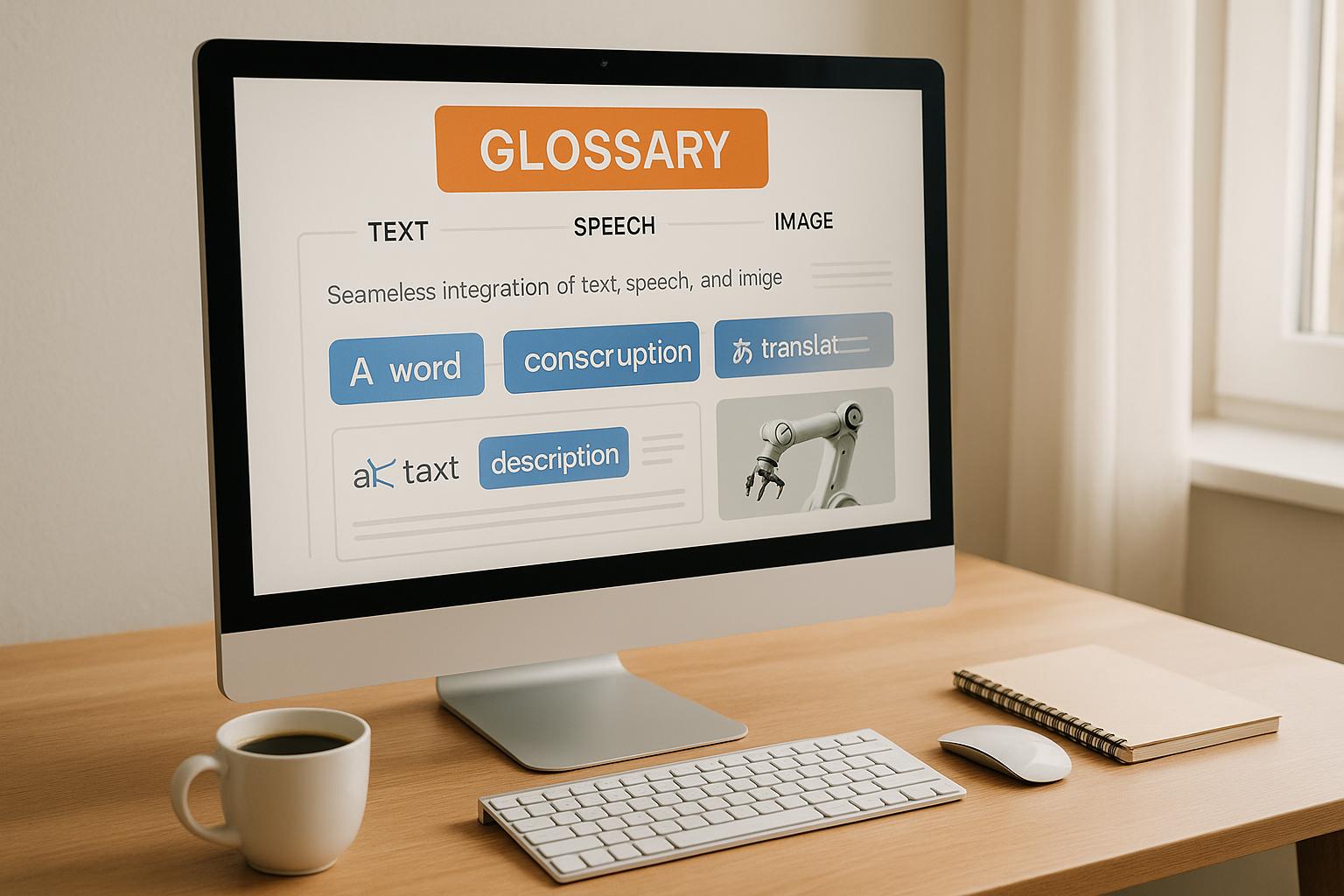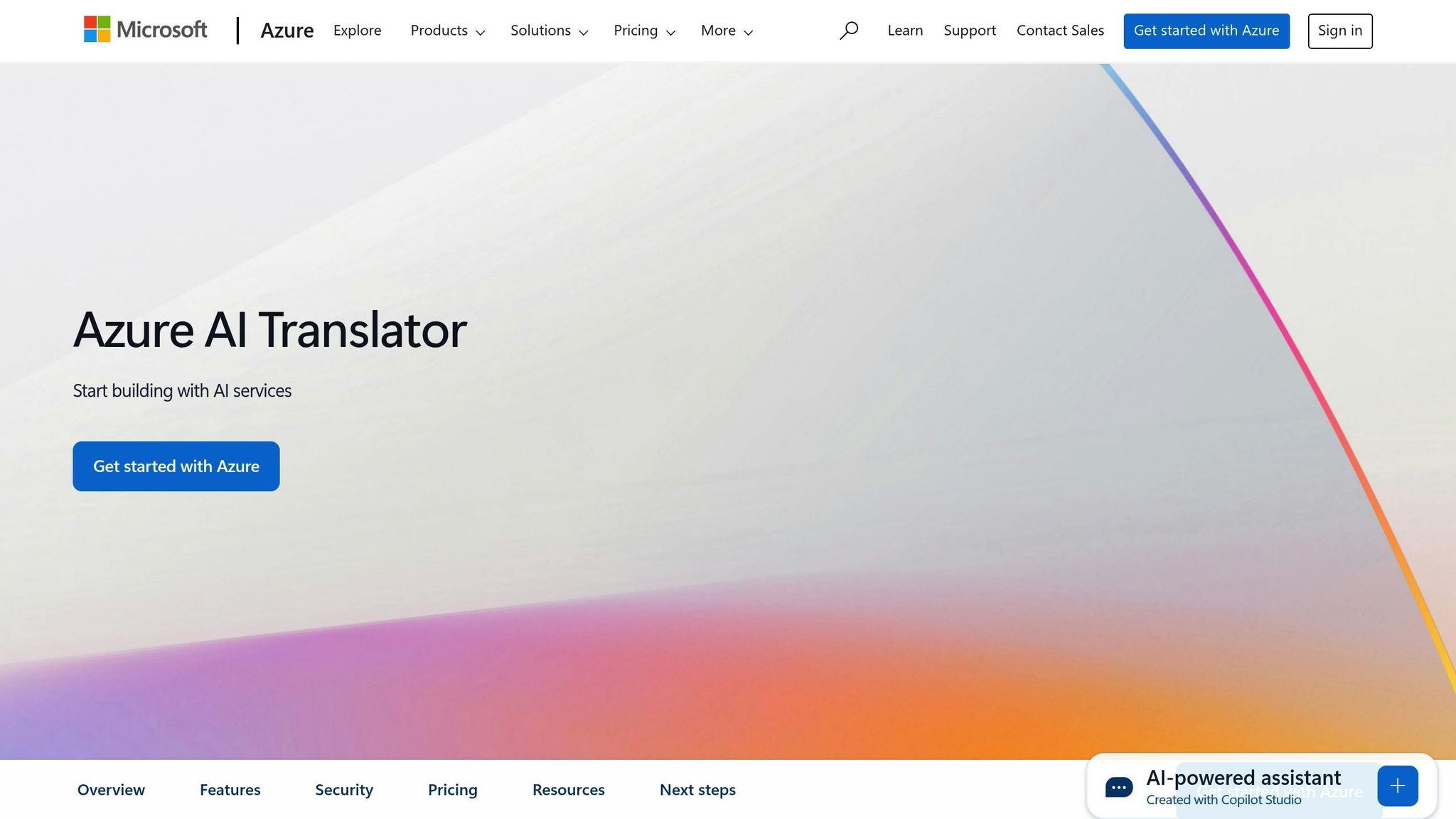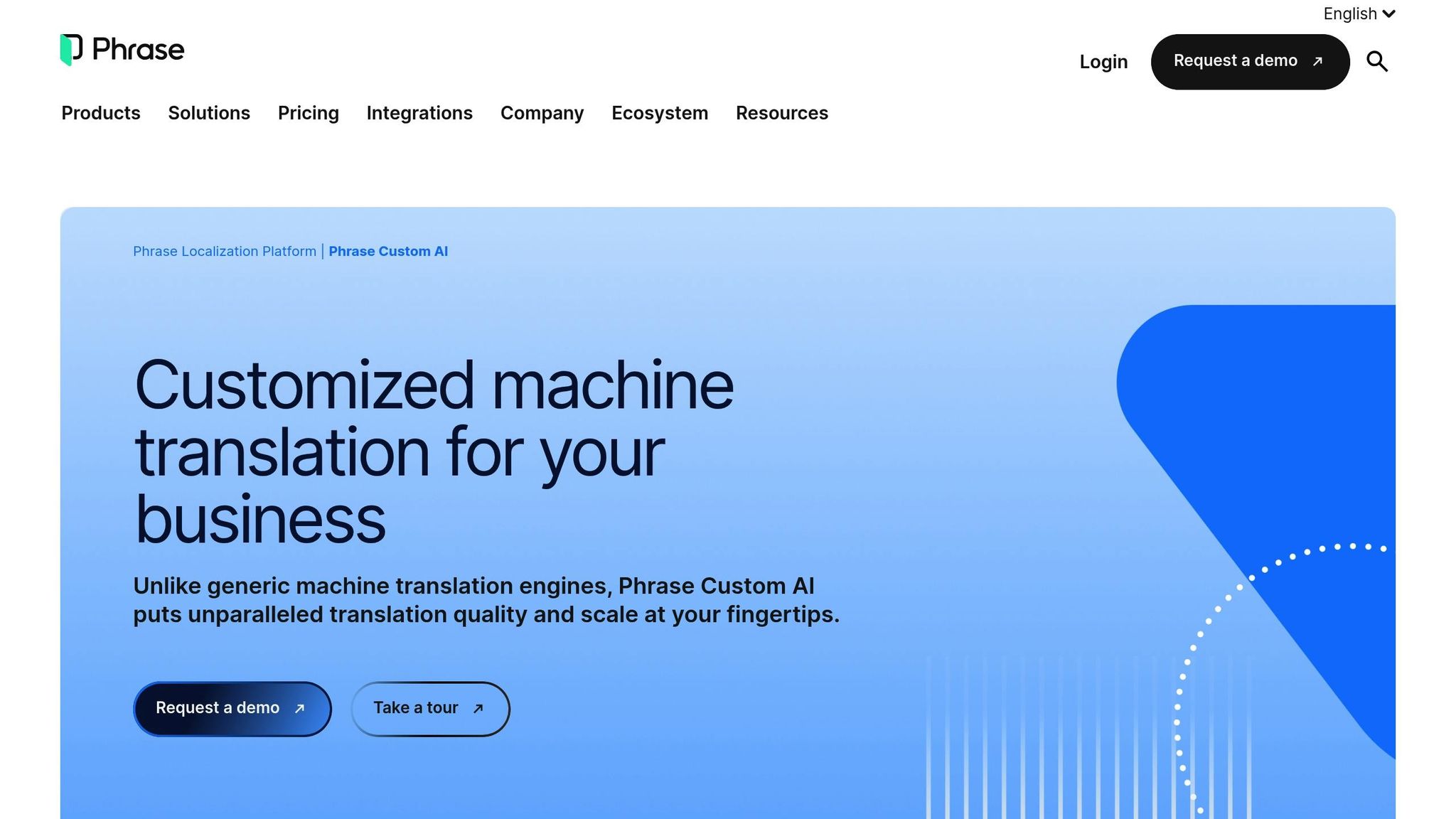
Custom glossaries are transforming AI translation by standardizing terminology across text, speech, and images. They ensure consistent translations for industries dealing with specialized terms, branding, and technical language. This approach reduces localization costs by 60% and speeds up time-to-market by 80%. Leading platforms like prompts.ai, Azure AI Translator, and Phrase Custom AI offer unique solutions for managing glossaries, integrating multimodal workflows, and scaling for enterprise needs.
| Platform | Strengths | Weaknesses |
|---|---|---|
| Prompts.ai | Multimodal support, real-time collaboration, flexible pricing | Less established for enterprise use |
| Azure AI | Extensive language support, secure infrastructure, strong integration with Microsoft tools | Limited multimodal capabilities, glossary restricted to one-to-one language pairs |
| Phrase Custom AI | Customizable machine translation, broad compatibility with engines, precise terminology | Higher integration costs in complex IT environments |
These platforms cater to different needs, from handling diverse content formats to managing enterprise-scale translations. Choose based on your priorities: flexibility, security, or specialized terminology management.

Prompts.ai takes a fresh approach to integrating custom glossaries into multimodal AI workflows. By focusing on unifying AI operations, it ensures consistent terminology across text, speech, and images. Let’s dive into what makes this platform stand out.
Prompts.ai simplifies glossary management for multimodal workflows, emphasizing consistency across various content formats. At its core is a vector database designed for retrieval-augmented generation (RAG) applications. This allows organizations to store and retrieve custom terminology, ensuring specialized terms are applied consistently - whether in written text, audio transcriptions, or image-based text recognition.
The platform also offers a Real-Time Sync Tool within its AI Labs, which ensures that glossary updates are instantly reflected across all workflows. Teams can collaborate on glossary changes in real time, with updates automatically applied to connected AI models and systems.
Another highlight is its Interoperable LLM Workflows, which link over 35 large language models through a single interface. This eliminates the need for separate glossaries for each model, maintaining uniformity across systems.
Prompts.ai extends its capabilities to sketch-to-image prototyping and 3D model generation, ensuring glossary consistency even in visual content. When processing images containing text, the platform applies custom glossaries to maintain accuracy.
Additionally, its Custom Micro Workflows allow users to tailor processes based on content type. For example, technical documentation workflows can prioritize engineering terms, while marketing workflows can focus on brand-specific language. These workflows are designed to automatically apply the relevant glossary sections depending on the content’s source, type, or intended audience.
To address security concerns, the platform employs end-to-end encryption, keeping sensitive glossary data secure throughout the translation and processing stages. This makes it a reliable choice for organizations handling regulated or confidential content.
Beyond its integration features, Prompts.ai is built for scalability and cost-effectiveness. Its pay-as-you-go financial model allows organizations to scale operations based on actual usage, avoiding the fixed costs associated with traditional systems. This approach can reduce AI-related expenses by up to 98%, replacing over 35 disconnected AI tools and cutting costs by 95% in just 10 minutes.
The platform offers two pricing tiers:
Prompts.ai also includes a tokenization tracking system that provides detailed insights into glossary usage costs. This feature helps organizations identify frequently used terms and high-translation-volume workflows, enabling smarter decisions about glossary updates and workflow optimization.
For enterprises, the platform’s automated workflows can boost team productivity by up to 10 times by eliminating repetitive glossary management tasks. By converting fixed translation costs into flexible, on-demand solutions, Prompts.ai allows businesses to efficiently handle fluctuating translation needs without overinvesting in underutilized resources.

Microsoft's Azure AI Translator provides dependable and scalable translation services, supporting over 100 languages and offering advanced features like custom glossaries and multimodal integration. Let’s break down its key features, including glossary management, integration capabilities, and pricing options.
Azure AI Translator stands out with its robust glossary tools. Users can create custom glossaries using TSV files, ensuring specific terms are translated consistently. It also applies context-aware translations with adaptive case matching, whether for sentence fragments or full sentences. For organizations needing specialized translations, the Custom Translator feature offers the ability to train neural machine translation models using parallel documents. Even when complete datasets aren’t available, models can be trained using just dictionary data.
The platform integrates seamlessly with Microsoft’s ecosystem through its REST API, embedding translation capabilities into products like Word, PowerPoint, Teams, Edge, Visual Studio, and Bing. It supports both real-time chat translations and batch processing for large documents. Developers can tap into these features via the Microsoft Translator Text API v3, integrating translation functions directly into their applications.
Examples of real-world use include Volkswagen, which uses Azure AI Translator for instant, high-quality translations to connect with its global customers. Similarly, KPMG leverages the service to overcome language challenges in compliance advisory work.
Azure AI Translator offers flexible pricing plans to suit varying needs. Here’s a breakdown of standard costs:
For organizations with large-scale translation requirements, commitment tiers provide significant savings:
| Commitment Tier | Monthly Cost | Characters Included | Overage Rate |
|---|---|---|---|
| Tier 1 | US$2,055 | 250 million | US$8.22/million |
| Tier 2 | US$6,000 | 1 billion | US$6.00/million |
| Tier 3 | US$22,000 | 4 billion | US$5.50/million |
Custom model training costs US$10 per million combined source and target characters, capped at US$300 per session. Hosting a custom model is priced at US$10 per model, per region, each month. For enterprises with massive translation needs, the platform can handle up to 2.5 billion characters monthly at US$45,000, with reduced overage rates of US$18 per million characters. Its non-regional architecture ensures consistent service availability for global operations.
Sergey Galchenko, CTO of IntelePeer, highlighted the platform’s performance:
"The performance of Microsoft's FAST API for offline transcription far supersedes the competition. When comparing the same sample corpus, FAST API performed the best among the alternative services tested. It shined on low quality audio transcription, delivering results 70% better than other vendors."
This demonstrates Azure AI Translator’s ability to handle enterprise-level workloads while delivering high-quality, fast translations across various content types.

Phrase Custom AI focuses on two key areas: glossary management and integrating multimodal AI. Like other platforms in this space, it emphasizes consistent application of glossaries across various translation tasks. It also enables businesses to fine-tune machine translation (MT) models to align with their unique brand voice, tone, and specialized terminology.
One standout feature of Phrase Custom AI is its ability to manage MT glossaries effectively, ensuring consistent use of predefined translations. These glossaries work through a search-and-replace mechanism, maintaining uniformity across all translated content. Users can create, update, and manage multiple glossaries, attaching them to different MT profiles as needed. This functionality is compatible with major MT engines.
To maintain high translation quality, the platform recommends keeping glossaries straightforward and focused on critical terms.
Michael Iantosca, a recognized voice in the industry, highlights the importance of terminology management:
"Managed terminology is a prerequisite that must be developed before or in parallel with other semantic assets. An enterprise termbase is the source of truth for all the words used in our taxonomies, ontologies, knowledge graphs, and in the content itself."
The platform integrates these glossaries seamlessly into its multimodal AI workflows, which we'll explore next.
Phrase Custom AI connects directly with Phrase TMS through its Language AI API, allowing organizations to scale high-quality, cost-efficient machine translation across their operations.
One of its standout features, the AI-powered Auto LQA, significantly reduces costs - by up to 65% - and cuts turnaround times by as much as 99%. Custom models are initially trained using Phrase’s proprietary MT engine, Phrase NextMT.
In December 2024, the platform launched its upgraded Contentful 2.0 integration, which was designed to handle complex localization workflows with speed, reliability, and scalability. This update helps businesses stay competitive in fast-moving markets.
Georg Ell, CEO of Phrase, shared his perspective on these advancements:
"With these AI innovations, we continue to push the boundaries of what's possible in localization - transforming tasks that were once costly, labor-intensive, and unscalable into processes that are lightning-fast, accurate, and fully customizable."
This integration not only enhances operational efficiency but also ensures scalability for enterprise-wide deployment.
Like other platforms such as prompts.ai and Azure AI Translator, Phrase Custom AI relies on a cloud-based infrastructure to support seamless scaling and cost control. This design can lower expansion costs by 40–60% and reduce annual maintenance expenses to 15–30% of the initial implementation costs. While cloud-based systems provide predictable maintenance costs, operational expenses may increase as usage grows.
Phased implementation strategies also help businesses minimize up-front costs and achieve faster results. However, in highly fragmented IT environments, integration efforts can account for 25–40% of the total AI budget. With over 70% of independent language professionals already using machine translation to some extent, tools like translation memory can reduce translation time by up to 40% and cut project costs by more than 30%.
Georg Ell emphasized the company's position in the market:
"The recent Nimdzi Compass positioned Phrase as a New Visionary – a player that disrupts the market. These latest releases continue our consistent approach to innovation and there is plenty more to come."
Each platform brings its own set of strengths and limitations when it comes to custom glossary integration. Understanding these differences can help you choose the right tool for your specific translation needs.
| Platform | Strengths | Weaknesses |
|---|---|---|
| prompts.ai | • Handles multimodal prompts across text, image, and video formats • Pay-as-you-go pricing with tokenization tracking • Real-time collaboration and automated reporting • Flexible workflows with interoperable LLMs |
• Limited details on dedicated glossary management features • Newer platform with a less established track record for enterprise use |
| Azure AI Translator | • Supports translations in over 100 languages • Offers custom glossaries for context-specific terminology • Built on secure cloud infrastructure with strong data privacy measures • Backed by Microsoft’s $20 billion investment in cybersecurity |
• Glossary feature limited to one-to-one source-to-target language translation • Case-sensitive glossary application by default • Lacks robust multimodal capabilities compared to specialized platforms |
| Phrase Custom AI | • Customizable machine learning models that don’t require specialist skills • NextMT engine designed for precise terminology understanding • Automated Asset Curation ensures translation memory accuracy • Access to over 30 leading MT engines, including Google, DeepL, and Amazon |
• No specific weaknesses identified |
This table provides a quick overview, but diving deeper into each platform reveals how their unique features align with broader translation strategies.
For instance, Azure AI Translator simplifies glossary creation but limits its functionality to one-to-one language pairs. This can be a drawback for projects requiring broader multilingual support. On the other hand, Phrase Custom AI stands out with its NextMT engine, which is tailored for precise terminology. As the company explains:
"Phrase NextMT, our groundbreaking TMS-ready MT engine, can be fine-tuned to understand your specific terminology in your target language, ensuring translations aren't just accurate but contextually relevant."
When it comes to multimodal support, prompts.ai takes the lead with its ability to handle text, image, and video formats. In contrast, Azure AI Translator focuses heavily on text-based translations, while Phrase Custom AI leverages its TMS integration and translation memory to adapt outputs with high accuracy.
Scalability also plays a key role in selecting a platform. Cloud-based solutions offer the flexibility to scale operations, but costs can increase significantly with higher usage, particularly when dealing with large volumes of multimodal content and custom glossary needs. Organizations should weigh these factors carefully to strike the right balance between performance and cost efficiency.
Bringing custom glossaries into multimodal AI requires careful consideration of translation needs, budget constraints, and technical requirements. Here’s how some leading platforms stack up:
prompts.ai stands out for its ability to streamline workflows across text, image, and video content. With its transparent pay-as-you-go pricing model, it’s an excellent option for businesses juggling multiple content formats within a single workflow.
On the other hand, Azure AI Translator offers a robust infrastructure tailored for enterprises prioritizing security. Its extensive language support makes it a strong contender for global organizations with strict compliance needs.
For industries with specialized terminology, Phrase Custom AI shines. It provides advanced tools for managing terminology and integrates multiple translation engines to deliver highly customized results.
When deciding between platforms, usage patterns play a key role. A pay-as-you-go model suits businesses with variable needs, while fixed-cost solutions are better for high-volume operations. For companies managing technical documentation, platforms that incorporate translation memory and maintain detailed terminology databases are invaluable. These features not only enhance accuracy but also help reduce operational costs.
Ultimately, the best platform depends on your priorities. If your focus is on handling diverse content types, prompts.ai might be the right fit. For organizations that emphasize enterprise-level security, Azure AI Translator could be the better choice. Meanwhile, industries with highly specialized language requirements may benefit most from the customized solutions offered by Phrase Custom AI. This comparison highlights the strategic advantage of integrating custom glossaries into multimodal AI translation workflows.
Custom glossaries are a game-changer for improving translation accuracy and maintaining consistency in multimodal AI systems. By integrating domain-specific terms and pre-approved translations, they help ensure the AI delivers precise and uniform translations across different languages and scenarios.
These glossaries also enhance the AI's ability to understand and interpret context from various input types - whether it's text, speech, or images. This means translations are not only accurate but also aligned with the cultural and contextual nuances of the target language. The result? A more reliable and efficient system, capable of managing complex, multilingual tasks with ease.
Prompts.ai makes managing custom glossaries a breeze by incorporating multimodal prompts - a blend of text, images, and videos. This approach improves how AI systems interpret context, leading to translations that are both precise and consistent, no matter the content type.
With features like real-time collaboration and automated workflows, the platform streamlines the process of managing multilingual and multi-format content. It’s a go-to solution for handling the challenges of complex AI systems that demand accurate glossary management and flexibility across different media formats.
The pay-as-you-go pricing model from prompts.ai is designed to be budget-friendly by charging based on actual usage - whether that's per word or character. This means no fixed subscription fees and the flexibility to adjust costs based on your specific needs.
This setup works especially well for startups and small businesses. It helps avoid wasting money on unused services or excess capacity. With this model, you're only paying for what you actively use, making it easier to keep expenses under control while still accessing top-notch translation tools tailored to your operations.


